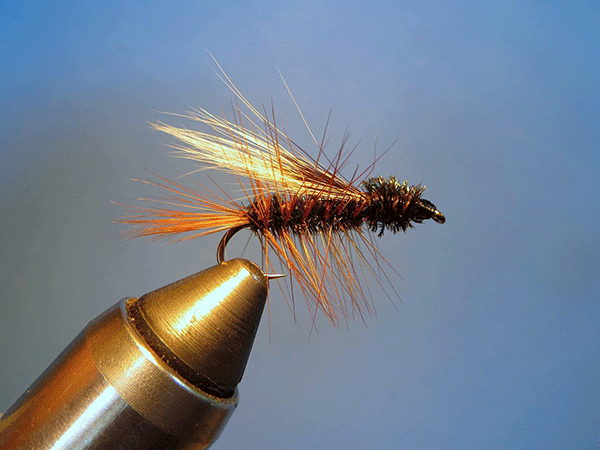
Over the centuries, countless fly patterns have been lost to history. Some have made brief resurgences in popular fly fishing culture, only to disappear and hibernate again, waiting for their next 10 seconds of fame. Still, it’s fair to say that there are probably dozens (if not hundreds) of once-popular patterns that modern fly anglers have never heard of.
Perhaps it’s because the allure of using patterns with high-tech modern materials is stronger that researching the classics. But there’s one classic pattern that I think deserves attention–especially the attention of tenkara anglers. The Picket Pin.
The Picket Pin was developed in the early 1900s by Montana tackle shop owner Jack Boehme and while the style has changed over the years, its effectiveness has not. It’s one of those very simple patterns that seems to have dialed in the right materials and design elements to be a fish magnet. I’ve used smaller size for stream trout, larger sized for trout in lakes, and have even landed steelhead on them!
Why is it good for Tenkara?
Like tenkara, the Picket Pin is highly versatile and instantly adaptable to different presentations without switching patterns. Like any good candidate for a “one fly”, it can be fished in a variety of ways:
1. Cast upstream and fished in a dead drift like a nymph
2. Stripped in like a streamer
3. Fished on the surface as a stonefly or hopper
4. Swung downstream like a wet fly
5. Pulsed like a sakasa kebari
6. Skittered across the surface like a caddis
While the original version was intended to imitate a stonefly, its profile and materials make it buggy looking enough to be mistaken for a multitude of aquatic food sources–especially tied in various sizes.
Another reason I think this is a good fly is that it’s fairly easy to tie and uses common, easy-to-find materials. If you’re a fly tier, you probably have all the materials you need to tie one right now.
Recipe
Here are the materials for the most commonly used recipe.
Hook: Your choice (usually a standard or 2-3X long nymph hook)
Tail: Brown hackle fibers
Body: Peacock herl
Ribbing: Sm. gold wire
Hackle: Brown saddle
Wing: Grey squirrel tail
Head: Peacock herl
How to tie the Picket Pin
Here’s an excellent video by Tim Flagler of Tightline Productions on how to tie the Picket Pin and a little more history on the fly.
While the version in the video above is probably the most popular, this pattern lends itself to a lot of experimentation. You could try peacock herl dyed in different colors (even use contrasting colors for the head and the body), use different hair for the wing and tail, different colored wire, etc. You can also tie it on shorter hooks to give it a more more robust appearance, or longer shank hooks to give it a more slender profile. I’ve even seen beadhead versions of the fly. With so many different possibilities, you’re only limited by your imagination.
If you haven’t tried a Picket Pin, you owe it to yourself to buy or tie a few up and give them a shot. I think you’ll find this classic fits in very well with tenkara’s philosophy and techniques.








Thank you for reminding me about this fly and for attaching the tying video. I read about the Picket Pin years ago but forgot about it. One of my favorite old flies is the Soldier Palmer which was popular in the late 1700s in the colonies. It is still used in Ireland.
jim
Hey Jim, I’ve fished the soldier palmer with tenkara. great fly. Here’s an article I wrote a while back about palmered flies for tenkara: http://www.tenkarausa.com/palmered-flies-for-tenkara/
Jason, really liked this article, I marked the YT video for watch later. Thanks
great article. i especially enjoyed the video. it’s a gem. thanks so much for sharing.
Nice article Jason. Who was the tier in the video. I recognized his voice but can’t remember who. Great narration and demo!
Hi Mike, it was Tim Flagler of Tightline Productions: http://www.tightlinevideo.com/
Picket Pin is a folksy common name given to describe the Columbia Ground Squirrel, which is fairly common all a cross the western US. The Picket Pin fly pattern was so named because it was originally tied with the ground squirrel’s hair – usually from the tail of the ground squirrel. And it was intended to be a dry fly in the beginning but, as you have pointed out so well it is highly effective in just about any way anyone may care to fish it.
Ground Squirrel tails are pretty hard, but not impossible I believe, to come by commercially. So the fly tier wanting to have an authentic Picket Pin fly pattern may have to resort to shooting and curing his own squirrel tails from wild sources, which have a much more mottled look to them and are a different color than either red or gray squirrel tails.
Thanks Jason! I always like it when you share fly patterns.
Never heard of this fly, looks great- so i tied it! Was fun to learn to tie and now will see how it fares against the trout.
That’s great Adam! Let us know how it works.
I’ve been running into this fly in New England here and there. Haven’t had a chance to fish one though. But for a while I had it confused with the Picket Finn, a Fran Betters creation.
Muy buena la tècnica para simplificar atado, fijando cola, luego alambre, herl , pluma y el hilo atràs, para avanzar con herl y el hilo, luego pluma y alambre. Lo usarè en distintas moscas!!!
Hola Mariano! No me gusta usar pegamento en mis moscas.